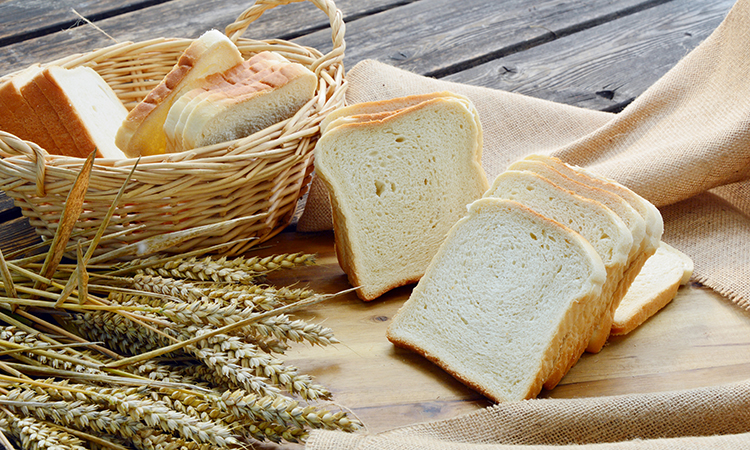Have scientists found a replacement for wheat flour in white bread?
- Like
- Digg
- Del
- Tumblr
- VKontakte
- Buffer
- Love This
- Odnoklassniki
- Meneame
- Blogger
- Amazon
- Yahoo Mail
- Gmail
- AOL
- Newsvine
- HackerNews
- Evernote
- MySpace
- Mail.ru
- Viadeo
- Line
- Comments
- Yummly
- SMS
- Viber
- Telegram
- Subscribe
- Skype
- Facebook Messenger
- Kakao
- LiveJournal
- Yammer
- Edgar
- Fintel
- Mix
- Instapaper
- Copy Link
Posted: 11 January 2021 | Joshua Minchin (New Food) | No comments yet
A research team thinks that its chickpea-derived flour can produce equally tasty white bread and decrease the risk of type 2 diabetes.


Wheat flour in white bread can cause blood sugar levels to rise sharply.
Researchers from the Quadram Institute and King’s College London have shown that replacing wheat flour with a new ingredient derived from chickpeas improved the glycaemic response (the rise in blood sugar observed after eating a meal) of people eating white bread.
The research team claims the new ingredient uses specially developed milling and drying processes that preserve cellular structure, making its starch more resistant to digestion. Developing food products that contain more of this resistant starch would help to control blood glucose levels and reduce the risk of type 2 diabetes.
Starch from wheat is a major source of dietary carbohydrate, but in bread and many other processed foods it is quickly digested to glucose in the body, causing a large spike in blood glucose levels. There is a large body of evidence that links long-term consumption of foods that provoke high glycaemic responses to the development of type 2 diabetes. With this condition on the rise, along with obesity and other metabolic disorders, providing foods and ingredients that help consumers better manage their blood glucose levels could help combat these health challenges.
Many pulses, such as chickpeas, peas, beans and lentils, naturally contain high amounts of resistant starch, which is digested slowly and avoids potentially damaging blood glucose spikes. However, when these crops are milled to flour and processed into food products most of this beneficial resistance is lost, rendering the starch highly digestible.
For this reason, the scientists invented an alternative milling process, which preserves the plant cell wall structures (dietary fibre) that surround the starch. This ‘Type 1’ resistant starch is the same as that found in wholefoods, but with the benefit that it can be used in a form that potentially allows it to be incorporated into a wider range of foods.
Funding from the Biotechnology and Biological Sciences Research Council (BBSRC), part of UK Research and Innovation (UKRI), was used to develop the commercial potential of this novel ingredient, referred to as PulseON®, and expands the possibilities for including large amounts of resistant starch in processed foods to improve nutritional quality.
Now, in a new study published in the journal Food Hydrocolloids, the research team has claimed for the first time that the resistant property of the starch is retained during bread making, and that people who ate bread rolls where some wheat flour was replaced by PulseON® had lower blood glucose responses.
In a double-blind randomised crossover study, the scientists replaced zero percent, 30 percent and 60 percent of the wheat flour in a standard white wheat bread recipe with PulseON®.
Healthy human participants consumed each of these bread roll types for breakfast in random order on separate days, with no knowledge of which type of roll they were eating. Their glucose levels were recorded using continuous glucose monitors.
Blood glucose responses to the PulseON®-enriched breads were on average 40 percent lower than after eating the control breads. All bread rolls contained similar amounts of starch and wheat protein (gluten) per serving, so the different blood glucose responses reflect the carbohydrate quality.
These results raise the possibility of using such foods for improving dietary management for diabetes patients, but must be evaluated in future studies.
The digestion of starch in each bread type was also studied in a laboratory using biochemical and microscopy techniques. These experiments showed that after two hours of digestion, the wheat starch had been fully digested, but the Type 1 resistant starch remained. This confirms that the lower glucose response to PulseON®-enriched breads was due to the resistant starch enclosed in the chickpea ingredient not being digested.
“Incorporating our new type of flour into bread and other staple foods provides an opportunity to develop the next generation of low glycaemic food products to support public health measures to improve health through better diets” said Dr Cathrina Edwards from the Quadram Institute.
“Consumers replacing wheat bread with PulseON®-enriched bread would benefit not only from the type 1 resistant starch, but also from the higher fibre and protein content.”
According to researchers, participants gave the PulseON®-enriched breads similar scores for texture and taste as the white bread. Quality tests indicated that any effects on bread quality (texture, appearance, etc) were subtle and most noticeable when large amounts of PulseON® were used.
Though scientists will need to test the sensory properties with a broader consumer group in a non-clinical setting, the results from the trial are nonetheless encouraging for efforts to produce healthier white bread without adverse effect on product quality.
Related topics
Health & Nutrition, Ingredients, Product Development, Technology & Innovation
Related organisations
King's College London, The Biotechnology and Biological Sciences Research Council (BBSRC), The Quadram Institute, UK Research and Innovation (UKRI)









